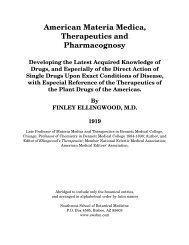SCARLET FEVER. Synonyms.—Scarlatina; Scarlet Rash. Definition ...
SCARLET FEVER. Synonyms.—Scarlatina; Scarlet Rash. Definition ...
SCARLET FEVER. Synonyms.—Scarlatina; Scarlet Rash. Definition ...
You also want an ePaper? Increase the reach of your titles
YUMPU automatically turns print PDFs into web optimized ePapers that Google loves.
spasms of the pharnyx and larynx, rendering deglutition and<br />
respiration very difficult; great prostration, a stage of paralysis, which<br />
generally terminates in death.<br />
Etiology.—The specific cause has not yet been determined, though<br />
bacteriologists agree that it is microbic in origin, that a toxin is<br />
developed which infects the saliva and blood of the victim. This is<br />
communicated to man in about ninety per cent of all cases by the bite of<br />
a rabid dog.<br />
The presence of saliva, however, on an abraded surface is sufficient to<br />
produce the disease. Of domestic animals liable to rabies, the cat, horse,<br />
and sheep are next in order, while a number of wild animals are<br />
susceptible, and when infected lose their shyness, timid animals<br />
becoming bold.<br />
Many persons seem immune, as only about twelve to fifteen per cent of<br />
the persons bitten contract the disease. The degree of immunity,<br />
however, most likely, is the result of the part bitten. Thus Ballinger<br />
states that ninety per cent of all persons bitten in the face contract<br />
rabies, while only a small per cent are affected when bitten on covered<br />
parts of the body, the virus being wiped off by the intervening clothing.<br />
It is quite rare in the United States, while in Russia it is quite common.<br />
The toxin seems to spend its force upon the central nervous system.<br />
Pathology.—The pathological changes found after death are not<br />
different from those in some other diseases, hence are not characteristic.<br />
Thus we find congestion of the mucous membrane of the pharynx,<br />
larynx, trachea, and bronchi, and sometimes of the lungs.<br />
The abdominal viscera is not affected. The blood-vessels of the cerebrospinal<br />
system are congested, and sometimes minute hemorrhages occur.<br />
These are most marked in the medulla and upper part of the spinal<br />
cord, but may be entirely absent.<br />
Symptoms.—The period of incubation is longer than that of any other<br />
known disease, and varies greatly in different cases, usually a shorter<br />
time in children than in adults. The intensity of the virus and location of<br />
the wound, in all probability, determine to some extent the time of the<br />
forming stage. When the injury is large and on the face or head, the<br />
toxin does its work more quickly.<br />
The Eclectic Practice of Medicine - PART I - Infectious Diseases - Page 246

















